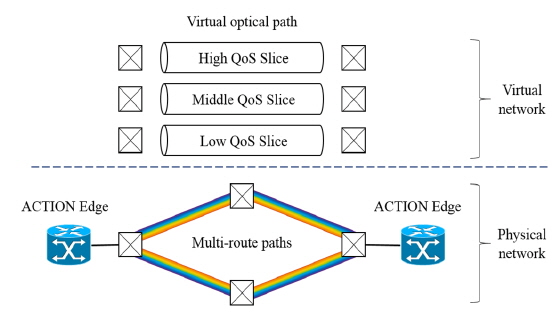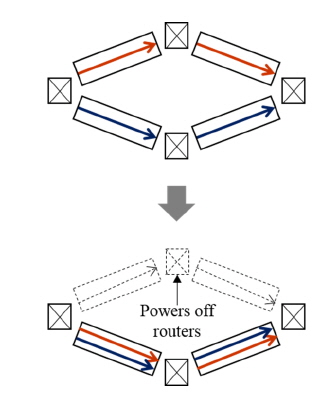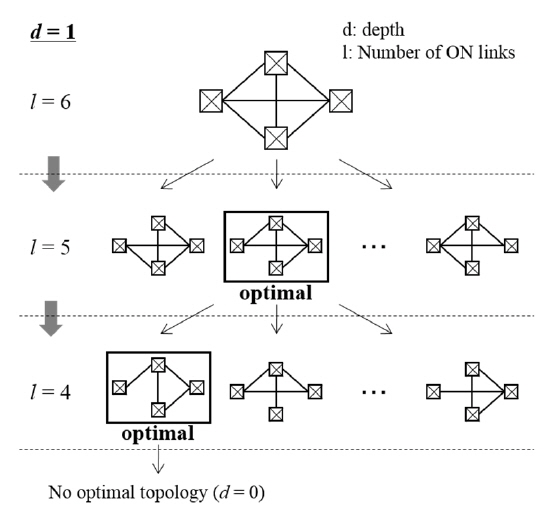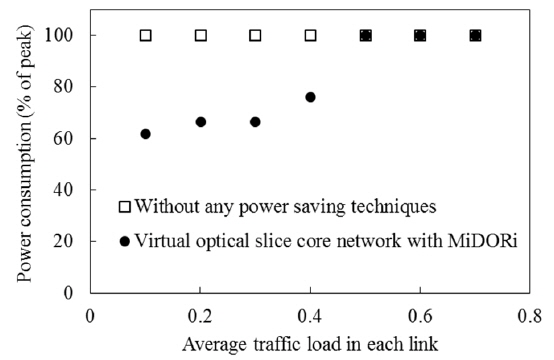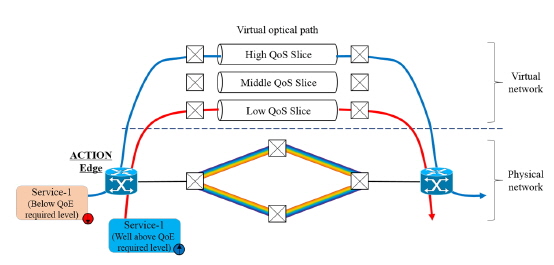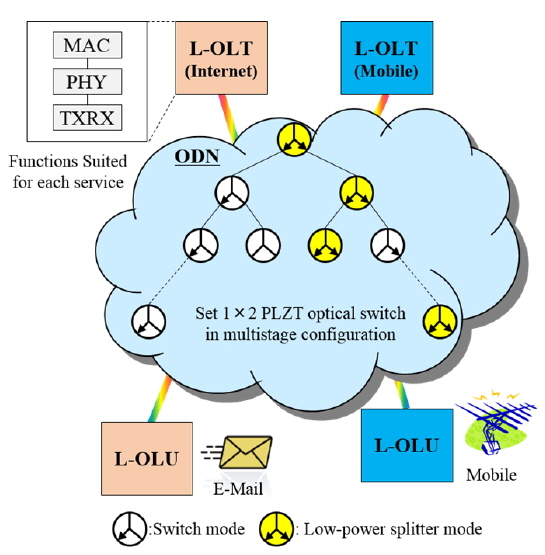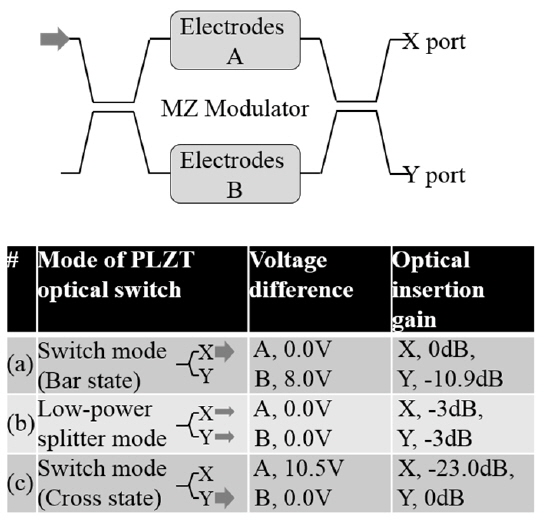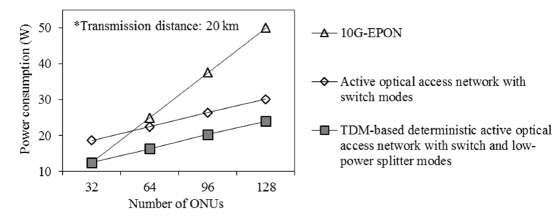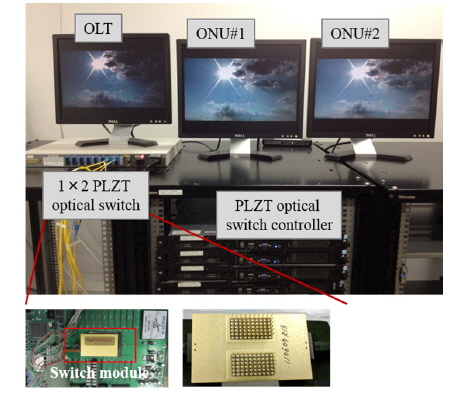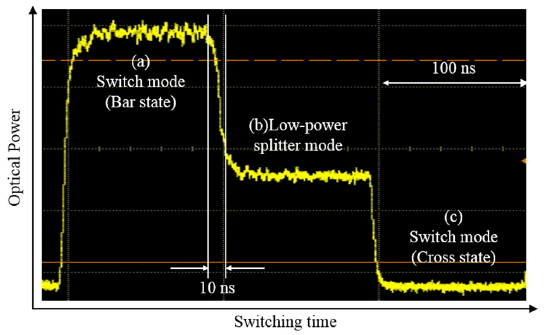



Today’s Internet supports a varied set of network services, including private line, mobile, residential Internet access, and inter-datacenter network, by simply over-provisioning links, e.g., 30% - 40% link utilization levels are quite common [2]. However low network utilization results in low energy efficiency levels, and thus increasing energy efficiency is an important requirement for future network designs. Therefore, in order to realize a multi-QoE, application-centric, and highly energy-efficient network, Applications Coordinated with Transport, Internet Protocol and Optical Networks (ACTION) [4], which leverages flexible elastic optical network technologies [5-7], has been proposed.
In this paper, we introduce a virtual optical slice core network and a Time Division Multiplexing (TDM)-based deterministic active optical access network in order to realize ACTION. The virtual optical slice core network can guarantee multi Quality of Services (QoS) by adjusting elastic optical pipe bandwidth and can provide an energy efficient network by adopting the Multi-(layer, path, and resources) Dynamically Optimized Routing (MiDORi) technique [8-13], which aggregates traffic onto a small number of links and powers off the routers that are not used to convey traffic. Also, the edge nodes of the core network, called ACTION edges, monitor application Quality of Experience (QoE) and assign flows to various multi-QoS slices. The TDM-based deterministic active optical access network can guarantee the various QoE requirements of each user in the access network based on QoS levels in the core network. It adopts the Optical Distribution network (ODN) by adopting Mach-Zehnder (MZ) type Plumbum Lanthanum Zirconate Titanate (PLZT) optical switches [14-16], which can support unicast and multicast states, in order to provide multi services and energy efficient network services, according to the user’s requirements.
There are mainly three problems in the today’s Internet: “users requiring different QoE levels”, “application divergence”, and “overprovisioning (which results in higher energy consumption levels)”.
Figure 1 shows the ACTION architecture [4], including the virtual optical slice core network and the TDM-based deterministic optical access network, which are introduced in this paper, in order to solve the above problems. This core network uses multi QoS optical slices to create multiple bandwidth pipes between nodes [5-7]. The ACTION edge nodes of the core network monitor each application’s QoE. This access network is comprised of the Logical-Optical Line Terminals (L-OLTs) [17], which provide functions suited for each network service, and the ODN, which adopts the MZ type PLZT optical switches [14-16].
III. VIRTUAL OPTICAL SLICE CORE NETWORK
Figure 2 shows the virtual optical slice core network, where multi-route paths can be aggregated into several virtual optical paths, including high, middle, and low QoS optical slices. The multi-QoS optical slices are established by the self-sizing elastic network technique [18]. All the virtual link utilization rates are monitored, and their bandwidth levels are adjusted to hit the utilization target. By using this technique, the link bandwidth can be adjusted to traffic levels automatically, and if needed, packets can be transmitted on parallel routes.
In order to reduce power consumption in the physical network, this core network introduces the MiDORi [8-13] technique. The MiDORi aggregates multiple traffic flows onto a small number of physical routes, creating highly utilized links wherever possible, and instructs the router to power-off unused interfaces whenever possible, as shown in Fig. 3.
Additionally, the MiDORi technique adopts the practical calculation algorithm determining an energy optimal topology [10], as represented in Fig. 4. This algorithm iterates the steps of replacing the topology with a local optimum topology with
1. Set the depth (d) of this algorithm. d is an integer value that changes from 1 to n - 1 (n is the total number of nodes). 2. Generate several patterns of topologies powering off d links from the original topology. 3. Check if each generated topology satisfies the QoS requirement and exclude those that do not. If no topologies meet the requirement, decrement d and return to Step 2. 4. Calculate the maximum link utilization for each remaining topology. 5. Select one topology that has the minimum value (m) of maximum link utilization and replace it with the original topology. If m exceeds 1.0, decrement d and return to Step 2. 6. Iterate from Step 2 to Step 5, while the connectivity of nodes is maintained. If not, decrement d and iterate the steps. 7. Stop all steps when d is decremented to 0. The remaining topology is decided as the energy optimal topology to be reconfigured.
Performance Evaluation for power consumption in the virtual optical slice core network: The simulation parameters are shown below. The topology assumed is the NSFnet, which has 14 nodes and 20 links. The link capacity is 1.0 for all links. The maximum traffic load for each link is 0.9. The depth (
Figure 6 shows the basic function of an ACTION Edge of the core network. It monitors the QoE of certain applications and modifies the transport network bandwidth automatically. If the QoE degradation is detected, the application’s flow is mapped to a slice with better QoS. On the other hand, if QoE is well above the required level, a lower QoS slice may be used.
However, the ACTION Edge has mainly two problems to be solved, including monitoring all TCP flows between source-destination pairs, especially in high-speed networks, and determining the desired QoE for each application.
In order to solve the first problem, we target α-flows, which are used for large-sized, high-rate flows [19, 20], for identification and for the provision of QoE assurance. Hybrid Network Traffic Engineering System (HNTES) technique [19], which is an intra-domain solution, can be used. This technique performs two tasks: (i) enables the automatic identification of flows at a provider network’s ingress routers, where source and destination address prefixes of observed α-flows can be used to configure firewall filter rules for future α-flow redirection, and (ii) redirects these flows to traffic-engineered QoS-controlled virtual circuits by using a no-policing and queuing solution with Weighted Fair Queueing (WFQ) and Priority Queueing (PQ), which are both sufficient and the best for this application.
In order to solve the second problem, we propose two methods: (i) an explicit method using signaling, and (ii) an implicit method by having a proxy function set QoE values at the ACTION Edge. The sender application can keep increasing the flow rate until the required QoE is met.
V. TDM-BASED DETERMINISTIC ACTIVE OPTICAL ACCESS NETWORK
Figure 7 shows the TDM-based deterministic active optical access network used to guarantee QoE requirements of each user based on the QoS levels available in the core network. This network is comprised of the L-OLTs [17], the Logical-Optical Network Units (L-ONUs), and the configurable ODN. Both L-OLT and L-ONU are structured by using reconfigurable logical devices and provide media access control (MAC) functions and physical (PHY) functions suited for each network service. In order to provide multi services and energy efficient network services, the ODN introduces the MZ type PLZT optical switches [14-16], which can switch an optical signal at nano-second speed (5-10 ns) and support unicast and multicast states. The switch consists of 1×
The MZ-type PLZT optical switch can yield the low-power splitter mode by applying no electric power to the switch, in addition to the normal switch modes which have bar and cross states of optical signal. Figure 8 shows the structure of a PLZT optical switch. In the normal switch modes, the optical signal is output in X port by applying the voltage (8.0V) to only electrodes B, called the bar state (a) and the optical signal is output in Y port by applying the voltage (10.5V) to only electrodes A, called the cross state (c). In the low-power splitter mode, the optical signal is output in both X and Y ports without applying any voltage (0.0V) to either electrode A or B, where the switch acts as a splitter (b).
Therefore, the ODN creatively uses the above three modes, while considering various users’ requirements, including the number of users, the transmission distance between L-OLT and L-ONUs, the permissible optical power to each user, and the required transmission method i.e. unicast or multicast.
Performance Evaluation for power consumption in the TDM-based active optical access network: In order to realize the low-power consumption network, we formulated the Integer Linear Programming (ILP) problem to maximize the number of PLZT optical switches used as the low-power splitter mode in the network, while considering the transmission distance and the permissible optical power to each user. The power consumption data of each component used in the simulation is shown below. One OLT is 12.5 W [21]. The 1×2, 1×4, 1×8, and 1×16 PLZT optical switches consume 2.5, 2.5, 2.6, 2.8 W, including the driver (2.48W) [15, 16], which has already been developed. The optical amplifier using Erbium Doped Fiber Amplifier (EDFA) consumes 8.0 W [21], where the nominal gain is 17 dB. The power consumption of each ONU is not included because it is a common element in each network. There are two comparison networks. The first network is the 10G-EPON [22], where the maximum number of ONUs per OLT is 32 and the maximum transmission distance between OLT and ONUs is 20 km and the optical amplifiers are needed when extending the network. Several extended-reach of amplified passive optical networks (PONs) have been proposed [23-25]. However, we use the 10G-EPON [22] as a basic PON architecture, which has been already standardized. The second network is the active optical access network with only switch modes of the PLZT optical switch, where the maximum number of ONUs per OLT is 128 and the maximum transmission distance between OLT and ONUs is 40 km [14].
Figure 9 shows that the TDM-based deterministic active optical access network with switch and low-power splitter modes reduces the power consumption by up to 52 %, compared to the 10G-EPON, and by up to 33 %, compared to the active optical access network with only switch modes, where the transmission distance between OLT and ONUs is 20 km. Figure 10 shows that the TDM-based deterministic active optical access network with switch and low-power splitter modes reduces the power consumption by up to 13 %, compared to the 10G-EPON, and by up to 33 %, compared to the active optical access network with only switch modes, where the number of ONUs is 32.
In this way, the TDM-based active optical access network realizes an energy efficient architecture, compared to the 10G-EPON [22] and the active optical access network with only switch modes [14].
Experimental setup of the prototype of TDM-based deterministic active optical access network: The prototype of the active optical access network has been demonstrated in the developed experimental system in Fig. 11. There are one OLT, two ONUs, and one PLZT optical switch with switch and low-power splitter modes. Tests on the experimental system for supporting unicast and multicast by switching the switch mode and the low-power splitter mode at 10ns confirmed the capability of the TDM-based deterministic active optical access network, as shown in Figs. 11 and 12.
This paper introduced a virtual optical slice core network and a TDM-based deterministic active optical access network for realizing ACTION. The virtual optical slice core can support multi QoS by using elastic optical pipes and provide an energy efficient network by adopting the MiDORi technique. Numerical results show that this core network adopting the MiDORi technique reduces the power consumption by up to 38 %, compared to without any power saving techniques. Also, the edge nodes of the core network, called ACTION edges, monitor application Quality of Experience (QoE) and assign flows to various multi-QoS slices. The TDM-based deterministic active optical access network can guarantee the various QoE requirements of each user in the access network based on QoS levels in the core network. It is possible to provide multi services and energy efficient network services by creatively using the switch and low-power splitter modes in the MZ type PLZT optical switch in the ODN. Numerical results show that this access network with switch and low-power splitter modes reduces the power consumption by up to 52 %, compared to the 10G-EPON and by up to 33 %, compared to the active optical access network with only switch modes. Also tests on the experimental system for supporting unicast and multicast by switching the switch mode and the low-power splitter mode at 10ns confirmed the capability of the TDM-based deterministic active optical access network.


